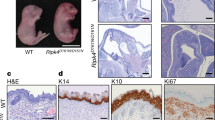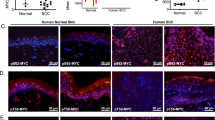Abstract
Matriptase/MT-SP1 is a novel tumor-associated type II transmembrane serine protease that is highly expressed in the epidermis, thymic stroma, and other epithelia. A null mutation was introduced into the Matriptase/MT-SP1 gene of mice to determine the role of Matriptase/MT-SP1 in epidermal development and neoplasia. Matriptase/MT-SP1-deficient mice developed to term but uniformly died within 48 h of birth. All epidermal surfaces of newborn mice were grossly abnormal with a dry, red, shiny, and wrinkled appearance. Matriptase/MT-SP1-deficiency caused striking malformations of the stratum corneum, characterized by dysmorphic and pleomorphic corneocytes and the absence of vesicular bodies in transitional layer cells. This aberrant skin development seriously compromised both inward and outward epidermal barrier function, leading to the rapid and fatal dehydration of Matriptase/MT-SP1-deficient pups. Loss of Matriptase/MT-SP1 also seriously affected hair follicle development resulting in generalized follicular hypoplasia, absence of erupted vibrissae, lack of vibrissal hair canal formation, ingrown vibrissae, and wholesale abortion of vibrissal follicles. Furthermore, Matriptase/MT-SP1-deficiency resulted in dramatically increased thymocyte apoptosis, and depletion of thymocytes. This study demonstrates that Matriptase/MT-SP1 has pleiotropic functions in the development of the epidermis, hair follicles, and cellular immune system.
This is a preview of subscription content, access via your institution
Access options
Subscribe to this journal
Receive 50 print issues and online access
$259.00 per year
only $5.18 per issue
Buy this article
- Purchase on Springer Link
- Instant access to full article PDF
Prices may be subject to local taxes which are calculated during checkout










Similar content being viewed by others
References
Andreasen PA, Christensen TH, Huang JY, Nielsen LS, Wilson EL, Dano K . 1986 Mol. Cell. Endocrinol. 45: 137–147
Andreasen PA, Egelund R, Petersen HH . 2000 Cell. Mol. Life Sci. 57: 25–40
Appel LF, Prout M, Abu-Shumays R, Hammonds A, Garbe JC, Fristrom D, Fristrom J . 1993 Proc. Natl. Acad. Sci. USA 90: 4937–4941
Benaud C, Dickson RB, Lin CY . 2001 Eur. J. Biochem. 268: 1439–1447
Blobel CP . 2000 Curr. Opin. Cell. Biol. 12: 606–612
Carmeliet P, Schoonjans L, Kieckens L, Ream B, Degen J, Bronson R, De Vos R, van den Oord JJ, Collen D, Mulligan RC . 1994 Nature 368: 419–424
Chen W, Jin W, Tian H, Sicurello P, Frank M, Orenstein JM, Wahl SM . 2001 J. Exp. Med. 194: 439–453
Damiano BP, Cheung WM, Santulli RJ, Fung-Leung WP, Ngo K, Ye RD, Darrow AL, Derian CK, de Garavilla L, Andrade-Gordon P . 1999 J. Pharmacol. Exp. Ther. 288: 671–678
Davidson P, Hardy M . 1952 J. Anat. 86: 342–356
Davisson MT, Cook SA, Johnson KR, Eicher EM . 1994 J. Hered. 85: 134–136
De Laurenzi V, Rogers GR, Hamrock DJ Marekov LN, Steinert PM, Compton JG, Markova N, Rizzo WB . 1996 Nat. Genet. 12: 52–57
Elias PM, Matsuyoshi N, Wu H, Lin C, Wang ZH, Brown BE, Stanley JR . 2001 J. Cell. Biol. 153: 243–249
Esler WP, Wolfe MS . 2001 Science 293: 1449–1454
Flanagan SP . 1966 Genet. Res. 8: 295–309
Hooper JD, Clements JA, Quigley JP, Antalis TM . 2001 J. Biol. Chem. 276: 857–860
Huber M, Rettler I, Bernasconi K, Frenk E, Lavrijsen SP, Ponec M, Bon A, Lautenschlager S, Schorderet DF, Hohl D . 1995 Science 267: 525–528
Jensen PJ, Lavker RM . 1999 J. Invest. Dermatol. 112: 240–244
Jindo T, Tsuboi R, Takamori K, Ogawa H . 1998 J. Invest. Dermatol. 110: 338–342
Kaufmann MH, Bart S . 1999 The anatomical basis of mouse development Revised edition San Diego, CA: Academic Press
Kim MG, Chen C, Lyu MS, Cho EG, Park D, Kozak C, Schwartz RH . 1999 Immunogenetics 49: 420–428
Koch PJ, de Viragh PA, Schrarer E, Bundman D, Longley MA, Bickenbach J, Kawachi Y, Suga Y, Zhou Z, Huber M, Hohl D, Kartasova T, Jarnik M, Steven AC, Roop DR . 2000 J. Cell. Biol. 151: 389–400
Kubilus J, Tarascio AJ, Baden HP . 1979 Am. J. Hum. Genet. 31: 50–53
Lee SL, Dickson RB, Lin CY . 2000 J. Biol. Chem. 275: 36720–36725
Lee YR, Yamazaki M, Mitsui S, Tsuboi R, Ogawa H . 2001 J. Dermatol. Sci. 25: 156–163
Lin CY, Anders J, Johnson M, Dickson RB . 1999 J. Biol. Chem. 274: 18237–18242
Lindner G, Menrad A, Gherardi E, Merlino G, Welker P, Handjiski B, Roloff B, Paus R . 2000a FASEB J. 14: 319–332
Lindner JR, Kahn ML, Coughlin SR, Sambrano GR, Schauble E, Berstein D, Foy D, Hafezi-Moghadam A, Ley K . 2000b J. Immunol. 165: 6504–6510
Luttun A, Dewerchin M, Collen D, Carmeliet P . 2000 Curr. Atheroscler. Rep. 2: 407–416
Magerl M, Tobin DJ, Muller-Rover S, Hagen E, Lindner G, McKay IA, Paus R . 2001 J. Invest. Dermatol. 116: 947–955
Magin TM, McWhir J, Melton DW . 1992 Nucleic. Acids Res. 20: 3795–3796
Manley NR . 2000 Semin. Immunol. 12: 421–428
Mann NS, Mann SK . 1994 Proc. Soc. Exp. Bio. Med. 206: 114–118
Matrisian LM . 1999 Curr. Biol. 9: R776–R778
Matsuki M, Yamashita F, Ishida-Yamamoto A, Yamada K, Kinoshita C, Fushiki S, Ueda E, Morishima Y, Tabata K, Yasuno H, Hashida M, Iizuka H, Ikawa M, Okabe M, Kondoh G, Kinoshita T, Takeda J, Yamanishi K . 1998 Proc. Natl. Acad. Sci. USA 95: 1044–1049
McCawley LJ, O'Brien P, Hudson LG . 1998 J. Cell Physiol. 176: 255–265
Nakagawa T, Roth W, Wong P, Nelson A, Farr A, Deussing J, Villadangos JA, Ploegh H, Peters C, Rudensky AY . 1998 Science 280: 450–453
Nemes Z, Steinert PM . 1999 Exp. Mol. Med. 31: 5–19
Oberst M, Anders J, Xie B, Singh B, Ossandon M, Johnson M, Dickson RB, Lin CY . 2001 Am. J. Pathol. 158: 1301–1311
Presland RB, Dale BA . 2000 Crit. Rev. Oral. Biol. Med. 11: 383–408
Reske-Kunz AB, Scheid MP, Boyse EA . 1979 J. Exp. Med. 149: 228–233
Roop D . 1995 Science 267: 474–475
Russell LJ, DiGiovanna JJ, Rogers GR, Steinert PM, Hashem N, Compton JG, Bale SJ . 1995 Nat. Genet. 9: 279–283
Scott HS, Kudoh J, Wattenhofer M, Shibuya K, Berry A, Chrast R, Guipponi M, Wang J, Kawasaki K, Asakawa S, Minoshima S, Younus F, Mehdi SQ, Radhakrishna U, Papasavvas MP, Gehrig C, Rossier C, Korostishevsky M, Gal A, Shimizu N, Bonne-Tamir B, Antonarakis SE . 2001 Nat. Genet. 27: 59–63
Sebzda E, Mariathasan S, Ohteki T, Jones R, Bachmann MF, Ohashi PS . 1999 Annu. Rev. Immunol. 17: 829–874
Shapiro LJ, Weiss R, Buxman MM, Vidgoff J, Dimond RL, Roller JA, Wells RS . 1978 Lancet 2: 756–757
Shultz LD . 1988 Curr. Top. Microbiol. Immunol. 137: 216–222
Stella MC, Comoglio PM . 1999 Int. J. Biochem. Cell. Biol. 31: 1357–1362
Takeuchi T, Harris JL, Huang W, Yan KW, Couglin SR, Craik CS . 2000 J. Biol. Chem. 275: 26333–26342
Takeuchi T, Shuman MA, Craik CS . 1999 Proc. Natl. Acad. Sci. USA 96: 11054–11061
Tang BL . 2001 Int. J. Biochem. Cell. Biol. 33: 33–44
Tanimoto H, Underwood LJ, Wang Y, Shigemasa K, Parmley TH, O'Brien TJ . 2001 Tumour. Biol. 22: 104–114
Turk B, Turk D, Turk V . 2000 Biochim. Biophys. Acta 1477: 98–111
Vu TH, Werb Z . 2000 Genes Dev. 14: 2123–2133
Werb Z . 1997 Cell 91: 439–442
Werb Z, Vu TH, Rinkenberger JL, Coussens LM . 1999 Apmis 107: 11–18
Williams O, Brady HJ . 2001 Trends Immunol. 22: 107–111
Yamada K, Takabatake T, Takeshima K . 2000 Gene 252: 209–216
Yamazaki M, Tsuboi R, Lee YR, Ishidoh K, Mitsui S, Ogawa H . 1999 J. Investig. Dermatol. Symp. Proc. 4: 312–315
Yan W, Wu F, Morser J, Wu Q . 2000 Proc. Natl. Acad. Sci. USA 97: 8525–8529
Zhang Y, Cai X, Schlegelberger B, Zheng S . 1998 Cytogenet. Cell Genet. 83: 56–57
Acknowledgements
We thank the NIDCR gene targeting core for blastocyst injections, Drs Henning Birkedal-Hansen, Silvio Gukind, Kenn Holmbeck, Keld Danø, and Mary Jo Danton for critically reading the manuscript, Dr Panomwat Amornphimoltam for advice on keratin immunostaining, and Dr Ulrike Lichti for advice on hair canal formation. We also thank Yamei Gao, Elizabeth Smith, Hannah Aaronson, and David Mitola for their excellent technical assistance. K List was supported by fellowships from the Danish Cancer Society and Svend Cole Frederiksen and Hustrus Foundation.
Author information
Authors and Affiliations
Corresponding author
Rights and permissions
About this article
Cite this article
List, K., Haudenschild, C., Szabo, R. et al. Matriptase/MT-SP1 is required for postnatal survival, epidermal barrier function, hair follicle development, and thymic homeostasis. Oncogene 21, 3765–3779 (2002). https://doi.org/10.1038/sj.onc.1205502
Received:
Revised:
Accepted:
Published:
Issue Date:
DOI: https://doi.org/10.1038/sj.onc.1205502
Keywords
This article is cited by
-
Roles of host proteases in the entry of SARS-CoV-2
Animal Diseases (2023)
-
HAI-1 is required for the novel role of FGFBP1 in maintenance of cell morphology and F-actin rearrangement in human keratinocytes
Human Cell (2023)
-
Evolutionary history of type II transmembrane serine proteases involved in viral priming
Human Genetics (2022)
-
Targeted deletion of HAI-1 increases prostasin proteolysis but decreases matriptase proteolysis in human keratinocytes
Human Cell (2021)
-
Mild acidity likely accelerates the physiological matriptase autoactivation process: a comparative study between spontaneous and acid-induced matriptase zymogen activation
Human Cell (2020)



